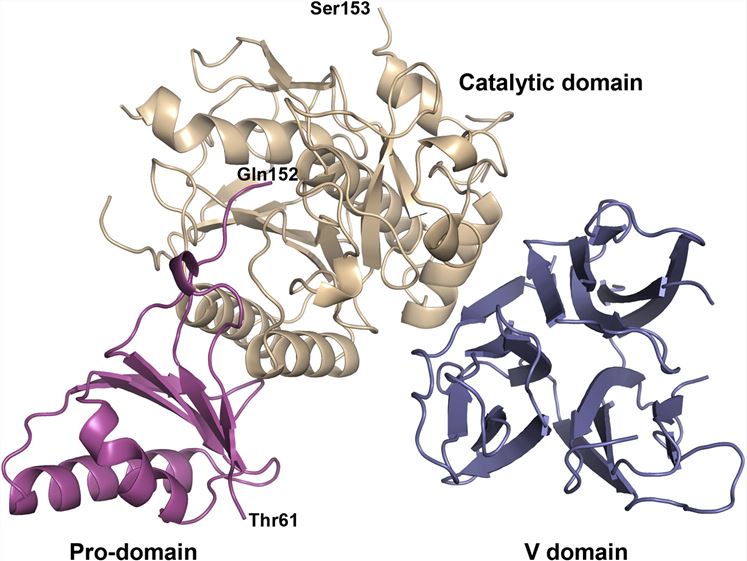What is PCSK9 Protein
In human biology, proteins often appear as central players, coordinating important physiological processes. Among them, PCSK9 (proprotein convertase subtilisin/Kexin type 9) has attracted considerable attention in recent years due to its key role in cholesterol metabolism.
PCSK9 is encoded by the PCSK9 gene mainly expressed in the liver and belongs to the proprotein convertase family. PCSK9 was identified in 2003 and has since become a focus of understanding cholesterol homeostasis. This protein acts as a molecular conductor and affects the levels of low-density lipoprotein (LDL) cholesterol in the bloodstream.
 Figure 1. Overall Structure of the PCSK9 Protein (Piper, D.E., et al. 2007)
Figure 1. Overall Structure of the PCSK9 Protein (Piper, D.E., et al. 2007)The Function of PCSK9 Protein
Central to PCSK9 function lies its complex interaction with the LDL receptor (LDLR) within hepatocytes. LDLR normally helps remove LDL cholesterol from the bloodstream, and PCSK9 regulates this process. It binds to LDLR, triggering a cascade of reactions that leads to the degradation of LDLR and blocks its recycling to the cell surface. This finely regulated interaction results in elevated levels of LDL cholesterol, which contributes to atherosclerosis and cardiovascular disease.
PCSK9-Related Diseases
PCSK9 dysregulation has been implicated in several diseases, among which familial hypercholesterolemia is particularly prominent. This genetic disorder, characterized by very high LDL cholesterol levels from an early age, poses a significant risk for premature cardiovascular disease. Beyond this, studies have shown that PCSK9 has broader effects, with PCSK9 being linked to metabolic disorders such as diabetes, highlighting the protein's multifaceted role in human health.
PCSK9 Related Signaling Pathways
Regulation of cholesterol by PCSK9 unfolds in a precisely coordinated molecular pathway. PCSK9 is synthesized in the endoplasmic reticulum and undergoes modification before secretion into the bloodstream. It interacts with LDLR on the surface of hepatocytes, triggering internalization and subsequent degradation, thus reducing LDLR availability. This process intricately links molecular events and provides the basis for targeted therapeutic intervention.
Applications of PCSK9 in Biomedical Research
- Hypercholesterolemia Treatment
Monoclonal antibodies designed to inhibit PCSK9 have emerged as breakthrough treatments. By neutralizing PCSK9, these inhibitors enable LDLR to persist on the cell surface, promoting the clearance of LDL cholesterol from the blood. This innovative approach brings hope to patients with familial hypercholesterolemia or those who have failed to respond to traditional treatments, opening up new frontiers in the treatment of hypercholesterolemia.
- Exploring Inflammatory Modulation
Recent studies have uncovered a potential link between PCSK9 and inflammation, a process integral to a variety of diseases, including cardiovascular disorders. This suggests that PCSK9 plays a broader role in regulating immune responses, providing an interesting avenue for therapeutic exploration. Unraveling the complexities of PCSK9's involvement in inflammation may open the door to new treatments.
PCSK9 not only provides a key to unlocking disease, but also provides a path to innovative biomedical intervention. As the scientific community digs deeper into the nuances of PCSK9, it promises to reshape our approach to cholesterol management, inflammation regulation and the broader field of personalized medicine.
Recommended Products for PCSK9 Protein
| Cat.# | Species | Product name | Source (Host) | Tag |
|---|---|---|---|---|
| PCSK9-169H | Human | Active Recombinant Human PCSK9 Protein, HIS-tagged | CHO | HIS |
| PCSK9-186H | Human | Active Recombinant Human PCSK9, His-tagged, Biotinylated | HEK293 | His |
| PCSK9-187H | Human | Active Recombinant Human PCSK9 protein, Avi-His-tagged, Biotinylated | HEK293 | Avi-His |
| PCSK9-184H | Human | Active Recombinant Human PCSK9 protein (Met 1-Gln 692), His-tagged | HEK293 | His |
| PCSK9-312H | Human | Recombinant Human PCSK9 protein, His-tagged | HEK293 | His |
| Pcsk9-259M | Mouse | Active Recombinant Mouse Pcsk9 protein, His-tagged | Mammalian cells | His |
| Pcsk9-663M | Mouse | Recombinant Mouse Pcsk9 protein, His-tagged | HEK293 | His |
| Pcsk9-1156R | Rat | Recombinant Rat Pcsk9 protein, His & GST-tagged | E.coli | His/GST |
| Pcsk9-915R | Rat | Active Recombinant Rat Pcsk9 protein, His-tagged | HEK293 | His |
| PCSK9-311R | Rhesus macaque | Active Recombinant Rhesus macaque PCSK9 protein, His-tagged | HEK293 | His |
Reference
- Piper, D.E., et al. The crystal structure of PCSK9: a regulator of plasma LDL-cholesterol. Structure. 2007, 15(5): 545-52.

